GESTURES OF PROTECTION
Gesture psychology - photo gallery of gestures, emotions and facial reactions to definition of Lie (Lie to me) training program
GESTURES OF PROTECTION - these are gestures by which it can be judged that a person during a conversation is inclined to protect his interests, defend his "I" or even evades discussion.
They respond to possible threats, conflict situations.
Gestures of defense (defensive) are also called - gestures of closure.
This group of signs includes gestures:
Arms crossed
(gesture related to "avoiding" the discussion)
When we see that the interlocutor has crossed his arms over his chest, we should review what we are doing or saying, because he is starting to move away from the discussion.
Crossed arms on the chest is an attempt to create a protective barrier in front of you, a fence that protects you from prying eyes and attention.
Most of the people around you do not understand this explicitly, but they will feel it unmistakably if they see this gesture.
Arms crossed
with thumbs accent
A very common gesture is when the arms on the chest are crossed, while the thumbs of both hands are vertically up.
This gesture has a double meaning.
- First - this gesture is a signal of a negative or defensive attitude towards the interlocutor.
- The second (accented fingers) is also emphasizing one’s superiority over the interlocutor.
Disguised Crosses
The arms crossed on the chest are a rather demonstrative expression of one’s true feelings (regardless of what the person is saying at that moment).
This gesture is used to hide and disguise your feelings as much as possible, to give them some innocent character. To do this, an object appears in the hands of a person (a scarf, flowers, gloves, a folder with documents, and so on).
This simple combination gives the pose or gesture a socially justified character, allowing you to hide your excitement, anxiety and nervousness even from a very experienced observer.
Clasped fingers
(lower, middle and upper positions)
A slightly different kind of masked gesture of crossed arms is the clasped fingers of the hands.
At first glance, this gesture may seem like a constructive and confidential gesture, since people who demonstrate it, as a rule, are smiling and portraying disposable and friendly faces.
In fact, this is a gesture of disappointment and hidden hostility, and with a spicy sauce that a person who is experiencing these feelings, wants to hide them with all his might.
Arms crossed in the abdomen
(gesture reminiscent of covering a causal place)
Quite often, people use softened, disguised barrier gestures that are not striking. One of these gestures of protection is a gesture when a person holds his hand.
The gesture of a “wall soccer player with a shear blow” unconsciously indicates a desire to be inconspicuous or not to draw a lot of attention to his person.
It is believed that this gesture, as it were, raises our layer of childhood memories of how the parent held our hands and we felt protected.
Hands clenched into fists
(or obna hand clenched)
As you know, in a state of anger, anger, or rage, our fingers clench into their fists by themselves.
Hands clenched into fists also indicate the defensive reaction of the speaker.
However, observing people, most often this gesture (clenched fists) corresponds to the spirit of the moment. Fingers are clenched into a fist exactly when a person says something sharp, angry, indignant and threatening.
LEARN to determine a lie on your own without a polygraph
Gestures are not an end in themselves, they are just road signs in communication.
They are able to show you how a person feels and change their strategy.
Theory without practice is dead!
Develop in yourself all the best.
Kiev Center for NLP and Training wishes you good luck in this!
Open a new page in career, business and a successful personal life!
P.S. Huge request - if you liked what you read and looked - click on any button on social networks:
Sometimes, to make a definite conclusion about a person, it is enough to look at how he is standing. And you can stand in very different ways.
You can stand with your head high and your shoulders straight. And you can stand, hunched over and head down. Hands can be lowered, crossed in front, or, conversely, brought down behind. And each of these provisions characterizes a person in a certain way, and you can understand what he feels at that moment, and, quite possibly, what he thinks.
Compare the two illustrations below. Both depict the meetings of Vladimir Putin: with Nikolai Aksyonenko and Mikhail Nikolayev, respectively. Compare the poses of the interlocutors of the president: they are very different from each other.
Vladimir Putin and Nikolai Aksyonenko
In the first case, we see a half-slope of the hull forward and an ingratiating glance, which tells us about the helpfulness and servility, desire and ability to bend to the higher authorities and to please him.
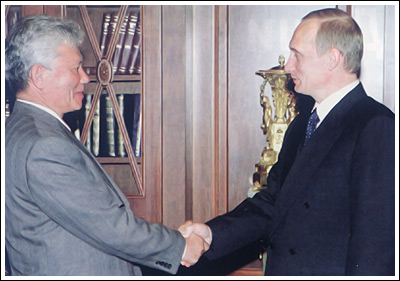
Vladimir Putin and Mikhail Nikolaev
In the second illustration, we see a straight posture, a firm look "eye to eye", not the slightest hint of his own secondary, strong handshake.
The pronounced symmetry of the poses: "we are equal, we are equal." Not a bit of subservience and order worship. Strong character, strong nature, you will not say anything. I respect
Arms crossed in front of you while standing
The gesture demonstrated by Aslan Maskhadov is typical of a person who is standing on stage (or in front of a large audience). A very characteristic gesture. Man, as it were, holds his hand.

Aslan Maskhadov
Why is this needed?
The thing is that in front of a large audience, our psychological stress increases. As a result, ignorance of where to put our hands is a sign of psychological anxiety, tension, anxiety.
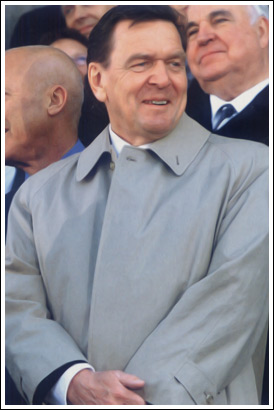
Gerhard Schroeder
If at this moment you cross your arms over your chest, then this is a protective gesture, saturated with anxiety. Crossed arms on the chest - an attempt to create a protective barrier in front of you, "blocking" from excessive attention. Viewers will feel this unmistakably if they see this gesture. A politician cannot afford to look so weak, so crossed arms are very rare on stage. For such cases, politicians use less obvious barrier gestures that are not striking.
One of these gestures - a man holding his own hand - is shown to us by Aslan Maskhadov and Gerhard Schroeder (see above).
The second version of this gesture (in a sitting position) can be seen in Bill Clinton.

Bill clinton
It is believed that this gesture raises the layer of childhood memories of how the parent held our hands and we felt protected. In adulthood, we do not always have this certainty that someone is loving, strong, and capable of protecting us. Therefore, we perform such a trick ourselves, for a while turning into a parent to ourselves and restoring a sense of emotional balance.
Posture and posture can also characterize a person.
An even stance, a slightly deflected body body back and a high-raised head indicate a fairly even character of a self-confident person.
We can also assume that little Aslan Maskhadov was probably held by his right hand (he holds his right hand with his left hand): psychologically, this is correct, as it frees the parent from unnecessary worries about the child (looking to the right is a visual construction of danger, if you remember )
Hands behind
In some cases, a person prefers to keep his hands behind his back. This is indicative: after all, crossing his arms in front, he seems to defend himself from other people, and here all protection is defiantly removed, all vulnerable areas of the body are open.

Saddam Hussein and his son Uday Hussein
That's right: such gestures are most often shown either by confident people or people in power professions: prison guards, officials, police, directors, politicians.
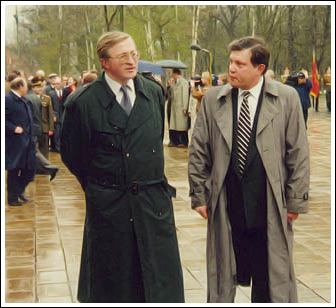
Alexander Shokhin
If you manage to look behind these people, you will find that they do it in different ways. If a person holds himself with one hand on the other above the wrist or even at the level of the elbow, we can say that he is upset. And the higher his hand holds the other (as if he says: “control yourself”), the more upset or angry he is.
If a person holds his wrist, then we can say: he is completely confident in himself and feels his superiority.

Alexander Rutskoi
The last example is clearly demonstrated by Alexander Rutskoi. It is curious that the photo was taken in court, where he was held by the accused in the case of the illegal export of foreign currency. As you can see, according to the gestures, he is not at all excited about what is happening and feels confident.
Laying hands behind the head
Some gestures clearly indicate superiority and high social status.
Can you imagine that someone, talking with the president, will put his hands behind his head like Anatoly Bykov does?
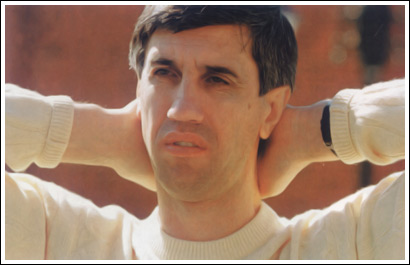
Anatoly Bykov
If you see a group of people, one of whom laid hands behind his head - this is the owner, boss or an authoritative person.
A typical gesture of the boss and the owner, talking with subordinates. Freud forbid you to do so, talking to the boss: he can become furious. But not because, of course, he understands what this gesture means, but because he intuitively feels that he has been challenged and wants to put you in his place.

Mustay Karim
The first and most characteristic meaning for such a gesture is power and emphasis on superiority. But not only. A gesture is typical of a successful person. This gesture is found in people who think that they all know. “I know everything, I am aware of all the events, I know everything,” is what this gesture can say.
Interlocked fingers: lower, middle and upper positions

Mikhail Kasyanov
A slightly different kind of masked gesture of crossed arms is shown to us by Mikhail Kasyanov. In the picture you see him facing Alexander Voloshin. In contrast to the gesture of Maskhadov holding his hand, Kasyanov demonstrates the lower position of the gesture of the clasped hands.
What does this gesture mean?
Alan Pease writes that the gesture may seem constructive and confidential, as the people who demonstrate it are smiling (see above), portraying friendliness. In fact, this is a gesture of disappointment and hidden hostility, and with a piquant sauce that a person who is experiencing these feelings, wants to hide them with all his might.
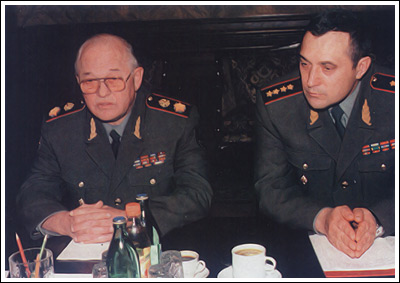
Igor Sergeev and Anatoly Kvashnin
In the picture, Anatoly Kvashnin and Igor Sergeyev (the picture was taken when Anatoly Kvashnin really wanted to become the Minister of Defense, and Igor Sergeyev really did not want this) are sitting at the negotiating table, and Sergeyev clearly shows us a gesture of clasped hands, only in his middle position.
The positions of the hands differ among themselves in the strength of negativism: the higher the fingers clasped in the fingers to the face, the stronger the negative feelings.

Evgeny Primakov
If we assume the emotional gradation of negative feelings experienced by a person with clasped fingers, the most negative option can be seen on the example of Yevgeny Primakov and Vladimir Putin. Fingers interlocked, upper pose of hands brought to face.

Vladimir Putin
A little less - Igor Sergeyev, and even less - Mikhail Kasyanov (see above).
Of course, it is far from always possible to draw such a conclusion: in some situations it is simply impossible to perform a defensive posture with all the strength of feelings. Kasyanov will not be able to bring his hands to his face with all his will. And if it can, it will be very striking, therefore such a desire is suppressed by an effort of will.
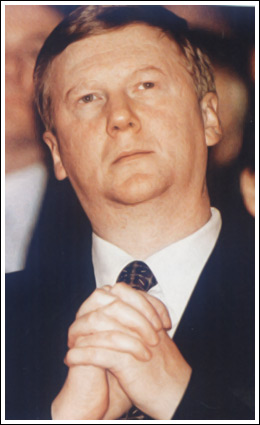
Anatoly Chubais
In negotiations, this is important, and while the interlocutor’s hands are clasped, it’s difficult to agree. He doesn’t like something much, and he needs to change his tactics so that he changes his position to a more profitable and positive one.
Judging by the illustrations, then you will not agree with Primakov and Chubais. It will be difficult to agree with Sergeyev, and a positive result is quite possible with Kasyanov (despite the fact that he does not like something). You need to change your line of behavior, reduce the emphasis on what worries him, and strengthen where he feels good. But remember, gestures are not an end in themselves. They are road signs in communication, suggesting where to turn and where it is better to slow down.
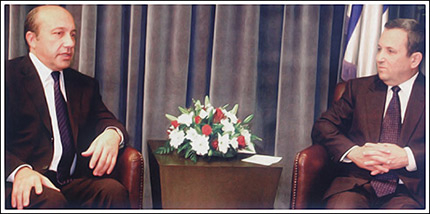
Igor Ivanov and Ehud Barak
To consolidate the material, we will look at the meeting of Igor Ivanov with Ehud Barak.
This illustration was accompanied by a comment that Igor Ivanov is Barak's most coveted guest. But now, seeing the clasped hands of an allegedly hospitable host, we can doubt it. Or not to believe at all.
Judging by the photograph, Igor Ivanov is more interested in this meeting (open position of the hands, without crossing), but not Barak (clasped hands in the middle position, which, as you remember, do not say anything good).
Arms crossed
We have already said that arms crossed in front of oneself mean a protective barrier, with the help of which a person fences himself from the surrounding world and unpleasant or disturbing situations. As a rule, politicians rarely cross their arms over their chest, for this gesture is of maximum defense. Nevertheless, this also occurs, and if you see the politician's arms crossed on his chest, you will not be mistaken in explaining his attitude to what is happening. Even if he smiles sweetly.
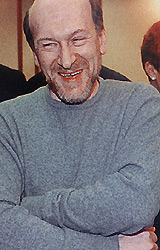
Arms crossed on the chest represent a natural attempt to hide from adverse situations, to find safety and protection. The gesture is interpreted quite widely: from self-doubt to a clear disagreement with you, but this is easily determined by the context. And to our favorite question: “And who stole the money from the budget?” - crossed arms will mean that the person who heard him at least really does not like your question.


By the way, gestures can be manipulated. And if after the question about stolen money you ask something like this: “Tell me, we know that you are absolutely not involved in this, and would like to know your opinion on whether it is possible to hope that this theft will be revealed?” - and your interlocutor will certainly spread his arms and remove his defensive position. The same things can be done in negotiations and in general, with any communications.
author Tsenev Vit 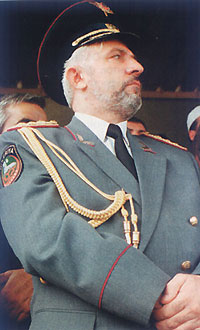
Hands crossed in front of themselves in a standing position The gesture that Aslan Maskhadov shows us is typical of a person who is on stage or in front of a large audience. This is a very characteristic gesture, pay attention to it. Man, as it were, holds himself for
From the book Political Body Language author Tsenev Vit 
Arms crossed on the chest with emphasis on the thumbs. A very common gesture is when the arms on the chest are crossed, while the thumbs of both hands are vertically up. As a rule, emphasizing the thumbs speaks of dominance, feeling
From the book Political Body Language author Tsenev Vit 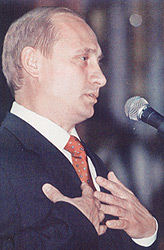
Heart gesture: the hand or both hands are pressed to the chest The chest has always been considered the receptacle of the soul, and without even having a clue what it is or what it really means, we often say that “it’s hard on the soul” or “the soul hurts”. There, of course, the region is located
From the book Myths about the Age of a Woman by Blair Pamela D.Breast "This last and significant segment of my life, old age, deserves my full attention and devotion." * * * Many older women are very afraid of breast cancer, and although 90% of us will never have it, there are still very good reasons.
From the book Why Men Lie and Women Roar by Piz Alan 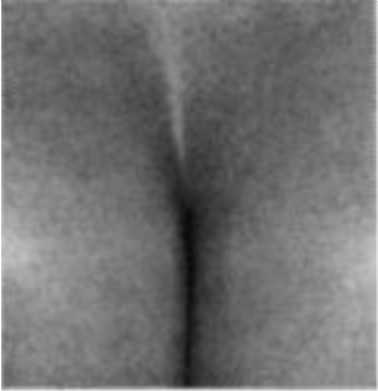
PRIORITY 3: FULL BREAST Breast of a woman who is at the peak of sexual and reproductive form (about twenty years) - this is one of the main factors that attract the attention of men. Look at men's magazines - and at each spread you will see wonderful examples of this
From the book Body Language [How to read the thoughts of others by their gestures] by Piz AlanHands on Breasts Shelter behind a partition is a natural reaction of a person, which he assimilates in early childhood for self-preservation. As a child, we hid behind tables, chairs, furniture and my mother’s skirt as soon as we found ourselves in a dangerous situation. From the book Do not be fooled! [Sign Language: What Paul Ekman Silented About] author Vem Alexander
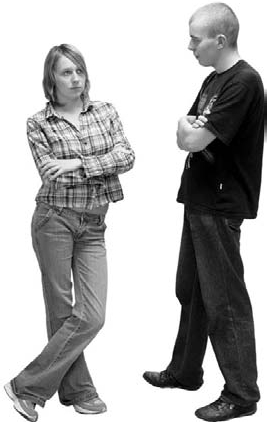
Crossed arms and legs. You came to the party. Observe who and how it costs. In 60% of those present, you will find either crossed arms, or crossed legs, or both at the same time. The party begins to "come to life", and relations between people are improving, as soon as
From the book Do not be fooled! [Sign Language: What Paul Ekman Silented About] author Vem Alexander 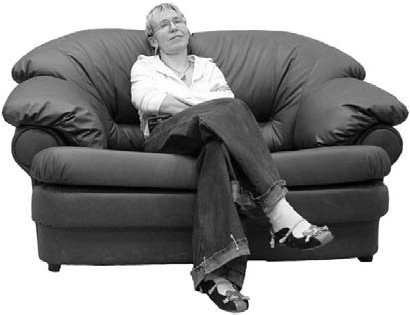
Crossed legs. This is a seemingly ordinary pose. She seems comfortable and completely innocent. However, NLPists claim that she is also
From the book The Art of Being a Woman the author Frolova Evgenia Valentinovna“Morning breathes on her chest.” Female breasts are what drive men crazy. She captivates their eyes, attracts her hands and lips, deprives them of their minds, incites their passion and desire. No wonder men come up with the most bizarre names for female breasts - buns,
From the book Family and Personality Development. Mother and child. the author Winnicott Donald Woods11. Weaning You now know me well enough to expect me to tell you about how and when to wean. There are many good methods, and you can get advice from your pediatrician or at the clinic. I want to talk about excommunication
From the book Live No Problem: The Secret to Easy Life by Mangan JamesGetting rid of chest pain Report: “For several hours now I have been feeling pain on the left side of the chest. What is this heart? This is impossible, because the last cardiogram showed that my heart is healthy. What should I do? I remembered the existence of the word contact that you
From the book The Structure and Laws of the Mind the author Zhikarentsev Vladimir VasilievichTesticles and breasts Two eggs and two breasts. Eggs and breasts contain life-giving moisture, the juice of life. Life is always contained where duality is, whole duality. Only two / forks can create and carry within itself
From the book French children always say “Thank you!” by Antje EdwigWeaning “Are you going to breast-feed him before the army?” The classic phrase, even though the call in France was canceled. This is because breastfeeding babies for more than six months is considered excessive custody. Most mothers take away
From the book Process mind. Guide to Establishing Communication with the Mind of God the author Mindell Arnold 
Hands on Breasts
Shelter behind a partition is a natural reaction of a person, which he assimilates in early childhood for self-preservation. As a child, we hid behind tables, chairs, furniture and my mother’s skirt as soon as we found ourselves in a dangerous situation. Growing up, we became more sophisticated in means of self-defense and, reaching the age of six, when the shelter behind the furniture would have become ridiculous, we learned to fold our arms and closely weave them on our chest with any signs of danger. In adolescence, we learned to make this gesture less pronounced, relaxing the interlacing of the hands a bit and combining this gesture with crossing the legs.
Growing up, we began to use this gesture so skillfully that its evidence became invisible to others. By placing one or both hands on our chests, we form a barrier. This, in essence, is an attempt to isolate oneself from an impending threat or undesirable circumstances. One can be sure if a person is nervous or takes a critical or protective posture, he crosses his arms on his chest. This is a clear signal that he feels danger or threat.
Research on this gesture has produced interesting results. A group of students was asked to attend a series of lectures and sit relaxed and at ease during the lectures, without throwing one foot over the other and not crossing arms on the chest. At the end of the lecture, a test was taken on the assimilation and memorization of the material, and the students' attitude to the lecturer was recorded. The second group of students did the same, only they listened to lectures with their arms crossed, tightly clenched. The results showed that the second group absorbed 38% less information than the first. In the second group, the opinion about the lecturer and the lecture itself was more critical.
These studies show that when the listener crosses his arms over his chest, he not only develops a negative attitude towards the speaker, but he also pays less attention to what he hears. Therefore, all training centers should have chairs with armrests in the classrooms, which will allow students to sit with their arms crossed on their chest.
Many people claim that they have a habit of folding their arms over their chests because it is a comfortable pose. Any gesture will be convenient if it matches your mood; that is, if you have a nervous, critical state, this gesture will seem very convenient for your mood.
Remember that in the process of communication, non-verbal information received from a person has a great influence on the recipient. It may be convenient for you to sit with your arms crossed on your chest, or with a tense back and an elongated neck, but; as studies have shown, this has a negative effect on the recipient.
Crossed Chest Hands - The Most Common Gesture
Hands in the lock on the chest express an attempt to hide from an adverse situation. The position of the hands with this gesture can be the most diverse, in this book we will discuss the three most characteristic positions. A typical, standard crossing of hands is a universal gesture, almost everywhere indicating the defense or negative state of a person doing this gesture. You can always see him, watching a person in a crowd of strangers at public meetings, in lines, in cafeterias, in elevators and in other places where people feel insecure and insecure.
Recently, during a lecture, I did the following experiment: at the beginning of the lecture, I specifically began to denigrate several people well-known and respected among those present at the seminar. After the audience listened to the flow of my criticisms, I asked them to freeze in the pose in which they were at the time of the hearing. What was their amazement when they saw that 90% of them were sitting with their hands folded on their chests, and they did it immediately after my verbal attack on the people they respected began. This clearly shows that most people take this pose when they disagree with what they hear. It often happens that public figures cannot infect an audience with their speech solely because they do not pay attention to the crossed position of their hands. Experienced speakers know that with this gesture it is necessary to take measures to "warm", "thaw" the audience. It is imperative that people adopt a more receptive posture and change their attitude towards the speaker.
When, when you are talking face to face, you see that your interlocutor is crossing his arms over his chest, you should conclude that you said something with which your interlocutor does not agree. Despite the fact that in words he will express agreement with you. The fact is that non-verbal means of communication cannot lie, while verbal means can. At this point, you should try to find out the reason for his gesture and encourage the person to take a more comfortable posture. Remember: as long as a person keeps his arms crossed on his chest, he will maintain a negative position. A tense internal state forces a person to accept this gesture, and maintaining the gesture maintains internal tension.
A simple but effective way to get a person to open their hands is to give them a pen, a book, paper, any object, taking which he will stretch his hands forward. Thus, he will take a more open position, and his attitude will change. You can also ask a person to lean forward in order to better consider some thing, as a result of which he will also open his hands. Another useful trick would be to lean forward with open hands and the question: "I see that you have questions. What would you like to ask?" Or “What do you think about this?”, And then lean back in the chair, showing that it was his turn to speak. Presenting your palms to him for review, you tell in a non-verbal way that you would like open and honest answer: As a sales agent, I never continued to present my product after I saw that my potential buyer unexpectedly folded his arms and tried to find out the reason why he did this. Moreover, I managed to notice when the buyer them There was a hidden objection that other agents would probably never have noticed, because they did not pay attention to non-verbal signals indicating disagreement.
Crossing Hands Strengthened By Finger Compression
If, in addition to crossing his arms on his chest, a man still clenches his fingers into a fist, this indicates his hostile and offensive position. Often this is accompanied by gritted teeth and a reddened face, in which case a verbal or physical attack may follow. A soothing gesture with open hands is needed to discover the cause of such hostile gestures (if you don't already know it). A person using a series of these gestures is in the attacking V position, unlike the person in Figure 67, who has taken a defensive, defensive position by crossing his arms over his chest.
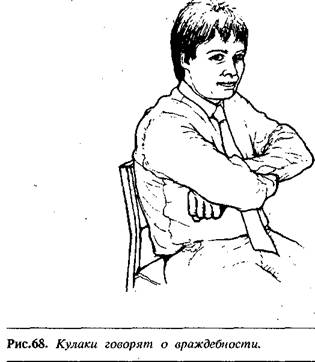
Crossed Hands on the Shoulder of the Arm
You may notice that this type of crossed arms is characterized by the fact that the hands are pressed into the shoulder of the opposite arm in order to fix the position of the arms, exclude any attempt to unclench the arms and expose the chest under attack. The hands can stick so tightly into the shoulder that the fingers and phalanges of the fingers turn white because blood does not flow to them.
This gesture can often be seen in the waiting room of a doctor or dentist, or in the cabin before taking off for people first flying on an airplane. It means containing negative feelings.

Among lawyers, one can observe the situation when the prosecutor and the defense attorney folded both hands on their chests, but the prosecutor’s fingers were clenched into a fist, and the defense attorney’s arms were clasped.
Social status influences the nature of the gesture associated with the crossing of hands. A person in a higher social position can emphasize his superiority by constantly holding his arms crossed in the presence of people just introduced to him. Let’s say that at the official reception, the chief manager was just introduced to several new employees with whom he had not previously been familiar. Having greeted them with a dominant handshake, he moves away from them to the distance of the social zone, and holds his hands behind his back, laying them in the pose characteristic of the boss (Fig. 42), or holds one hand in his pocket. He does not keep his arms crossed because he is nervous. New members of the company, on the other hand, having said hello to the boss’s hand, will take the pose of their arms fully or partially crossed, because they are in the presence of a high-ranking official. Both the CEO and new employees feel comfortable performing certain gestures, as each demonstrates their social status relative to the other. But what happens if the chief manager gets acquainted with a young, promising head of the department, who can even pretend that he is no less important by position than the chief manager. In all likelihood, after both shake hands in power, the young administrator will fold his arms over his chest, with his thumbs upright (Figure 70). This defensive gesture is a modification of the gesture in which both thumbs of the arms extended horizontally forward are set up, which indicates the person’s confidence and self-control. This gesture was used by Henry Winklers in the television series Happy Days. When we raise our thumbs up, we show that we feel confident, and our crossed arms give a feeling of security.
Sellers should analyze the situation when they see that the buyer made this gesture and see if they are negotiating correctly. If the gesture, using vertically placed thumbs, appeared at the end of the presentation of the product, and if it is accompanied by a number of other positive gestures on the part of the buyer, the sales agent can safely complete the presentation and talk about the order. If, at the end of the presentation, the buyer takes a pose of arms crossed with clenched fists (Fig. 68) and makes a completely blank face, you should not ask about the order, otherwise there may be tragic consequences. Instead, it’s better to return to the presentation of the product and ask a few questions to find out what the buyer’s objection is. In negotiations for a sale, it is very difficult to get a buyer to change his mind if he says: “No.” The ability to understand body language allows you to see that a person made a negative decision before he pronounces it, and this gives you the opportunity and time to change the course of things.

People wearing bulletproof vests rarely use hand-crossed gestures as a means of self-defense because their weapons or protective vests provide a reliable means of protection. Police officers armed with pistols, for example, very rarely use arms crossed on their chests, unless they are standing at the post, while they clench their fingers into fists to show that no one will go where they are.
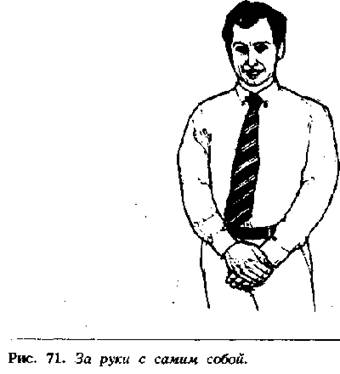
Incomplete Barrier formed by Hands
If you use the full gesture of crossing your arms, it will become obvious to those around you that you feel a sense of fear. Sometimes we replace it with partial, incomplete crossing, in which one arm is placed across the body, holding on to the other arm. This results in a barrier (see Fig. 72).
A person often uses a barrier from his hands, being in the company of strangers, or in the absence of self-confidence. Another common variant of an incomplete barrier is a gesture in which a person holds his hands by himself (Fig. 71). This gesture is usually used by people in front of a large audience when receiving an award or making a speech. Desmond Morris says that this gesture allows a person to restore the sense of emotional security that he experienced in childhood, when his parents held his hand in dangerous circumstances.

Disguised gestures associated with crossing their arms are very sophisticated, advanced gestures, which are resorted to by people who are constantly in the spotlight. This category of people includes politicians, salespeople, television commentators and others who do not want their viewers to notice their insecurity or nervousness. To make this gesture, the hand moves across the body towards the other hand, but instead of grasping this hand, it touches a handbag, bracelet, watch, cufflinks or some other object located on or next to the opposite hand ( fig. 73). Once again, a barrier forms and the state of security is asserted. When cufflinks were fashionable, it was often possible to see how men corrected them at that moment, as they had to pass through a room or a dance hall in front of everyone. Now cufflinks are out of fashion and men are adjusting the watch strap, checking the contents of their wallets, rubbing their hands, playing a button on the cuff or using any other excuse that allows them to hold their hands across the body that a person holds his hands (Fig. 71). This gesture is usually used by people in front of a large audience when receiving an award or making a speech. Desmond Morris says that this gesture allows a person to restore the sense of emotional security that he experienced in childhood, when his parents held his hand in dangerous circumstances.
Masked Hand Crossing Gestures
Disguised gestures associated with crossing their arms are very sophisticated, advanced gestures used by people who are constantly in the spotlight. This category of people includes politicians, salespeople, television commentators and others who do not want their viewers to notice their insecurity or nervousness. To make this gesture, the hand moves across the body towards the other hand, but instead of grasping this hand, it touches a handbag, bracelet, watch, cufflinks or some other object located on or next to the opposite hand ( fig. 73). Once again, a barrier forms and the state of security is asserted. When cufflinks were fashionable, it was often possible to see how men corrected them at that moment, as they had to pass through a room or a dance hall in front of everyone. Now cufflinks are out of fashion and men are adjusting the watch strap, checking the contents of their wallets, rubbing their hands, playing with a button on the cuff or using any other excuse that allows them to keep their arms across the body.

However, an experienced observer will never deceive these gestures, because they are made with the sole purpose of hiding the excitement and nervousness. A good place to observe these gestures is where people go through a group of people watching him, for example, a dance hall, where a person goes to an attractive young lady to invite her to a dance, or a spacious open room that a person crosses to receive awards. It is more difficult for women to notice this disguised protective gesture, because when they are unsure of themselves, they can hold on to items such as a handbag or wallet (Fig. 74). One of the most common variations of this gesture is to use both hands to hold a glass of wine or beer. It never occurred to you that one hand would be enough to hold a glass of wine? Using both hands allows an agitated person to form an almost invisible protective barrier with his hands. Having established that people resort to a disguised protective gesture in different circumstances, we also found that almost everyone uses it. Many popular people also use disguised protective gestures in stressful situations, and, as a rule, they don’t even realize that they do it.
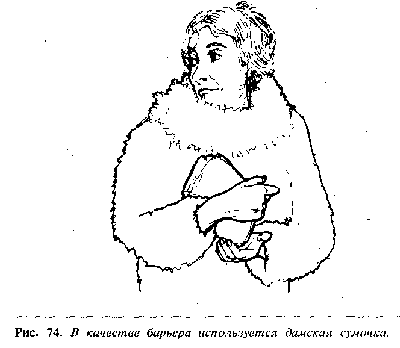

Chapter VII Protective barrier formed by legs
Crossing Feet
Like protective barriers formed with the help of hands, crossing the legs is a sign of a person’s negative or defensive attitude.
Crossing the arms on the chest was originally associated with the function of protecting the area of \u200b\u200bthe heart and chest, and crossing the legs is an attempt to protect the genital area. In addition, the crossing of the arms indicates a more negative mood of a person than the crossing of the legs, and the crossed arms are more evident. Caution should be taken in interpreting this gesture in women, since in childhood they were taught to sit like this because "the lady is sitting like that." Unfortunately, this manner can be construed as an attempt at defense.
There are two main postures with legs crossed in a sitting position - the (classic) standard leg-to-leg posture and the posture when the leg is rolled up resembles the number “4”.
European Foot Toe Method
One leg rests neatly on the other, usually right on the left - this is the normal position of the crossed legs used by Europeans, and can be used to express an excited state, restrained or protective position. This, however, is one of the auxiliary gestures, which is accompanied by other negative gestures, and should not be interpreted in isolation from the context. For example, people often sit cross-legged during lectures or during long sitting in uncomfortable chairs. Often people use this gesture in cold weather. When a crossed leg is also accompanied by a cross of arms on the chest (Fig. 77), this means that the person has "disconnected" from the conversation. It would be foolish for a salesman to even try to ask a buyer who has taken such a pose about his decision, and several clarifying questions should be asked to clarify his objections. This pose is very popular with women all over the world, especially if they want to express their dissatisfaction with her husband or friend.
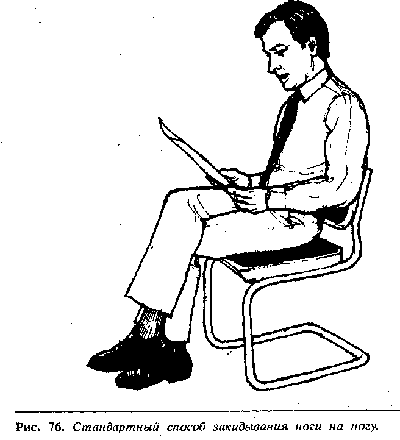

Toe-on-Toe with Angle Formation
This method of throwing legs on foot indicates that there is a spirit of competition and controversy. This way of sitting is very popular among male Americans who have a fighting character. Therefore, when dealing with Americans, it is difficult to determine whether they are making any sense in this gesture or not, but there is no such problem with the British.
Recently, I attended a series of meetings attended by 100 managers and 500 sales staff. A very controversial issue was discussed - the attitude of the corporation to its sales agents. One person from the team of agents, known to the audience for their reputation as “ringleaders,” was asked to speak. As soon as he stood at the podium, all managers, without exception, took up a defensive position (as shown in Fig. 77). This meant that they were afraid of ideas that, in their opinion, the speaker was going to express. Their concerns were well founded. This salesman is a metal thunder and lightning about the poor quality of management in most corporations in this industry and said that, in his opinion, this leads to personnel problems. During his speech, the rest of the salespeople leaned forward, which expresses a strong interest. Many made evaluative gestures, but managers steadfastly held a defensive posture. Then the speaker changed the subject, expressing his opinion on what should be the relationship between the two parties. Immediately, as if by the movement of the conductor’s stick, the position of the managers changed to an argumentative-opposing one (Fig. 78). It was obvious that they did not internally agree with the point of view of the opposite side, and later many confirmed that this was exactly the case. I noticed, however, that several managers did not accept this position. After the meeting, I asked them why they did not, and they explained that although they also did not agree with the speaker, they could not sit cross-legged because of their obesity or arthritis.
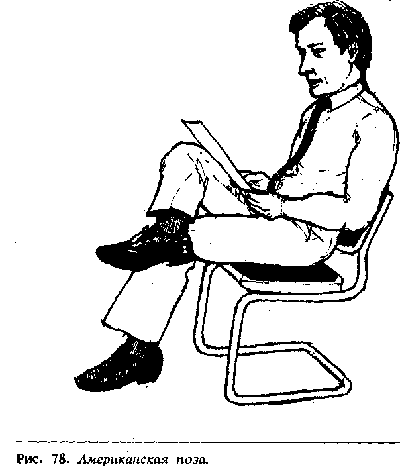
It would be unreasonable for the sales agent to end the presentation and ask about the order if the buyer took such a pose. He should openly address the buyer, leaning forward, palm up, and say: "I see you have any ideas on this. I would be interested to know your opinion." And then lean back, showing that it was the turn for the buyer to speak out on the problem. This allows the buyer to express their opinion. Sometimes women, if they are in trousers or jeans, can sit with their legs crossed so that the bent leg resembles the number "4".
Laying Foot On Foot With Fixing Legs With Hands
A person with a quick reaction, which is very difficult to convince in an argument, often sits with his legs crossed and his arms wrapped around his leg.
This is a sign of a stubborn, stubborn person who needs a special approach to achieve a common language.

Crossed Legs Standing
The next time you attend a meeting or a reception, pay attention to a small group of people standing with their legs crossed and their arms folded across their chests (Figure 80). When observing, you will see that they all stand at a much greater distance from each other than is customary and, if they are dressed in a jacket or jacket, the buttons will be tightly fastened. If you asked these people, you would find that either one of them or all of them are not familiar with each other. That is how people stand if there is a stranger among them.

And now pay attention to another small group in which people stand with relaxed hands, open palms, unbuttoned jackets, relaxed facial expressions, resting on one leg, while the other leg is turned with the toe towards the other members of the group. All members of this group easily penetrate each other's intimate zones. With careful observation, it becomes clear that people in this group are personally acquainted with each other or are friends. It is interesting to note that people standing with arms and legs crossed can have an unstressed expression and it seems that their conversation is flowing easily and naturally, but their posture indicates that they are tense or unsure of themselves.
Next time, joining a group of strangers who are standing in an open, friendly manner, stand in a pose with legs crossed and arms folded across the chest. One by one, the rest of the group will also take this pose and remain in it until you move away from them. Then step aside and see how, one by one, the group members will once again take their original open pose.
Stages of Relaxation Stressful Pose
As soon as people begin to feel comfortable and get closer to others, they obey the unwritten law, according to which the protective posture is changed to an open, unstressed one.
- Stage 1. Protective posture, arms and legs crossed (Fig. 81).
- Stage 2. The legs are no longer crossed, and the feet are in a neutral position.
- Stage 3. The hand, located on top, emerges from the lock of hands, the palm flickers during a conversation, but does not return to the castle.
- Stage 4. The hands are already open, and one hand freely gestures, it can go on the thigh or in your pocket.
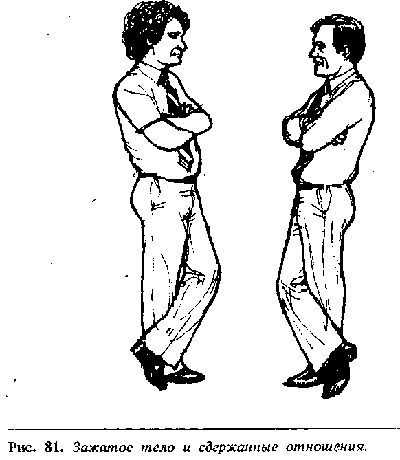
Stage 5. One person puts his leg back, and the other leg forward so that it points toe at the person who is interesting to him (Fig. 82).
Under the influence of alcohol, this process can go faster, or some stages may be lost.
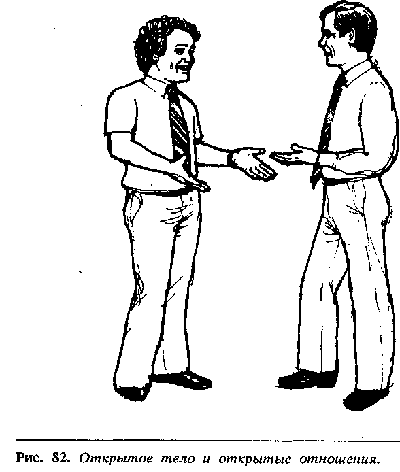
Defends itself - or maybe it’s frozen?
Many people claim that they cross their arms and legs not because they feel the need to defend themselves, but simply because they are cold. This is just an excuse, and it is interesting to note that there is a difference between a person in a defensive position and a frozen person.
First of all, if a person wants to warm his hands, he usually pushes them under his armpit, and does not put them under his elbows, as is the case with a defense pose.
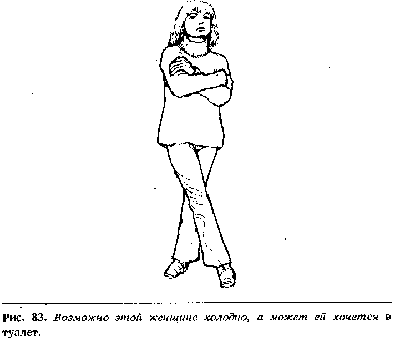
Second, when a person freezes, he can wrap himself in his arms. If his legs are crossed, they are usually straight, tense and closely pressed to each other (Fig. 83), which will differ from the more relaxed position of the legs in a protective position.
People who have the habit of crossing their arms and legs prefer. to claim that they are either frozen, or simply feel much more comfortable in this position. It is difficult for them to admit that they are nervous, embarrassed or protected from negative feelings.
Pressed To Each Other Ankles
Arms crossed or folded across the chest, legs crossed, suggest that the person is in a defensive or negative state, but the same thing can be expressed using the ankles brought together. In men, pressed ankles are usually combined with tightly clenched fists lying on the knees, or hands can bite into the arms of the chair (Fig. 84). The female version is slightly different: the knees are brought together, the legs can be inclined to one side, the arms lie either parallel to each other on the knees, or one hand on top of the other (Fig. 85).
More than a decade-long practice of communicating with people during business negotiations has shown that when your interlocutor pinches his ankles, this is equivalent to his "biting his lips." With this gesture, negative attitudes, unpleasant emotions, fear, or emotion are restrained. For example, my friend, a lawyer, told me that he often noticed that while giving testimony in the investigator’s office, all the people involved in the case were sitting with their ankles tightly pressed. He also noticed that at this moment they are ready to say something important, or are trying to control their emotional state.
When conducting interviews with applicants for a vacant position, we noticed that most of them at some certain point in the interview necessarily made this gesture, from which it was clear that they were holding back their excitement. When we began to study the nature of this gesture, we found out that talking about a person’s inner experiences does not help relax his ankles, and, consequently, his thoughts. But then we noticed that if the interviewer comes to the visitor’s table and sits next to him so that the table doesn’t separate them, his legs immediately relax, and the conversation takes on a more frank, more personal character.


Recently, we advised one company on the efficient use of the telephone to communicate with customers. We happened to talk with a young man whose job was to ring up customers who did not pay the bills. We watched his work and, although his voice sounded relaxed, we noticed that his ankles were closely pressed to each other. I asked: "Do you like this work?" He replied: “Oh yes, this is a wonderful work,” said, however, did not correspond to his non-verbal signals, although he spoke very convincingly. "Are you sure?" I asked. After a short pause, he relaxed his legs, turned to me, and, opening his palms, said: "In fact, she drives me crazy!" He further told me that during conversations some customers were rude to him, and he had to restrain his emotions so that his condition would not be passed on to other "customers. It is interesting to note that those sales agents who do not like to talk on the phone are sitting in this with tight ankles.
Well-known negotiating researchers Nirenberg and Calero found that when one participant clamped ankles during negotiations, this meant that he “clamped” the price concession. They found that using negotiation techniques could influence a partner by forcing him to unclench his ankles and make a concession.
Some people claim that they have a habit of sitting with their ankles pressed down (or in any of the poses with arms and legs crossed), because this is how they feel comfortable. If you also relate to these people, pay attention to the fact that your arms and legs will feel comfortable when you take a defensive, negative or restrained posture. Considering that a negative gesture can strengthen and prolong negative emotions, as well as the fact that other people may think that you are negative, I would advise you to learn how to use positive and open gestures to strengthen your self-confidence and improve relationships with other people.
Women who were teenagers in the era of miniskirts and wore a miniskirt clasped their legs and ankles for obvious reasons. Thanks to this habit, many women still sit in this position, which may be misinterpreted by others: people can be wary of them. Therefore, before making any conclusions, it is important to take into account women's fashion trends, in particular, how this affects the position of the woman's legs.
Fixing the Feet of One Leg on the Shin of the Other
This gesture is used almost exclusively by women. The foot of one leg wraps around the other leg to strengthen the defensive position. And when this gesture appears, you can be sure that the woman inwardly shrank and went into herself, like a tortoise under a shell. A gentle, friendly and warm approach is required if you are hoping to open this clip. This behavior is characteristic of shy and modest women. I recall the case when a young insurance agent tried to take out insurance for a young couple. This attempt was unsuccessful, and he could not understand why it failed: he seemed to follow all the rules of the sale. I pointed out to him that he had not noticed how the woman sat throughout the conversation, wrapping her leg tightly around her leg. If the insurance agent paid attention to this gesture, he would be able to interest her in the benefits of such insurance and achieve better results.

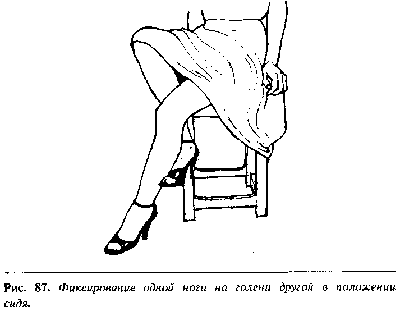
Chapter VIII Other Known Gestures and Movements
Horseback Chair
Many centuries ago, men used shields to defend themselves against the spears and batons of enemies, and today a civilized man uses everything that comes to hand for such a symbolic shield with which he defends himself from physical or verbal attacks. This can be a shelter behind a fence, a door, a table, an open car door or the back of a chair while sitting on top of it (Fig. 88). The back of a chair serves as a protective measure and can turn it into an aggressive, attacking warrior.
Most horse-riding enthusiasts are people of a dominant type who try to control and dominate people if they are bored by the topic of conversation, and the back of the chair serves as a good defense against any attack from others. This is a very cautious person and can completely imperceptibly and unexpectedly sit on a chair on horseback.
The easiest way to disarm the rider is to stand up or sit behind it, from which he will feel the rear is vulnerable in the event of an attack and will change his posture, becoming less aggressive. It is especially good to do this as a group, then the insecurity of the back will definitely make the rider change his position .
But how will you act in a one-on-one situation with such a person if he sits on a swivel chair? It is useless to try to tempt him, especially if he is spinning, like on a carousel, in his chair? It is best to use non-verbal means of attack.
Conduct a conversation, standing above him, and look at him from top to bottom, stepping on his personal territory. This will unsettle him so much that he may even fall off his chair, trying to resist an attempt to force him to change his pose.
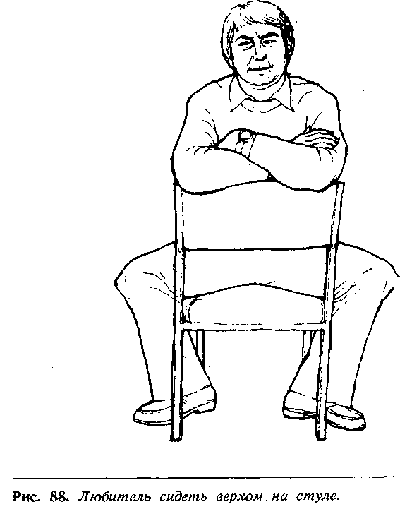
If an amateur came to sit on a chair "on horseback", and his aggressive manner annoys you, try to transplant him into a stable chair with armrests that will prevent him from taking his favorite pose.
Gathering Non-Existing Villi
When a person does not agree with the opinion or attitude of other people, but does not dare to express his point of view, he makes gestures, which are called gestures of repression, i.e. they appear as a result of restraining one's opinion. Gathering, plucking non-existent villi from clothes is one such gesture. The person plucking the villi usually sits, turning away from the others, and looks at the floor, and at this time he is engaged in his small inconsequential business; This is the most popular gesture of disapproval, and when the listener is constantly stripping his hair from his clothes, this is a sure sign that he does not like everything that is said here, even if he practically agrees with everything in words.
Turning your palms towards him, say: "What do you think?" or "I see that you have some thoughts about this. Please share." Sit back in a chair, palms visible, and wait for an answer. If a person says that he agrees with you, but continues to pluck the villi, you can ask him directly about the objection, which he does not dare to raise.

Gestures of the Head
This book would not be complete without a discussion of the main head movements, of which the two most frequently used are the affirmative nod of the head and the negative shake of the head.
An affirmative nod of the head is a positive gesture used in many countries to indicate "Yes" or approval.
Studies conducted with people from birth by the deaf, dumb and blind show that they also use this gesture to express a statement, which gave reason to believe that this gesture is innate. A negative head shake with the value “No” is also considered by many to be an innate gesture, however, a number of scientists believe that this is the first acquired gesture of a person.
They claim that when the baby gets milk, he turns his head from side to side, pushing away the mother’s chest. Similarly, when a small child is full, he turns away from the spoon, turning his head from side to side.
The easiest way to recognize a hidden objection is to see if the person is using the negative shake of his head when he verbally expresses his consent with you. Take, for example, the person who says: “Yes, I understand your point of view” or “I really like to work here” or “We will definitely start our business after Christmas,” and at that time he shakes his head from side to side. Even if his voice sounds convincing, the signal given by the head indicates a negative attitude, and I would advise you not to believe what he said and ask some sort of clarifying question.
Key Positions
There are three main positions of the head. The first is a straight head (Fig. 90). This position of the head is characteristic of a person who is neutral in relation to what he hears. The head is usually motionless, and from time to time small head nods are made. With this position of the head, hand-to-face evaluative gestures are often used.
When the head is tilted to the side, this indicates that the person has aroused interest (Fig. 91). Charles Darwin was one of the first to notice that people, like animals, tilt their heads to the side when they become interested in something. If you are making a presentation of a product or giving a speech, keep an eye on whether this gesture has appeared in your audience. When you see that they have tilted their heads to one side and their bodies forward, and rest their chin on their hand, then you have achieved your goal. Women use this head position to show their interest in an attractive man. When they come to you, all you have to do is tilt your head to the side and nod your head from time to time. In this way, you will gain favor with the speaker.
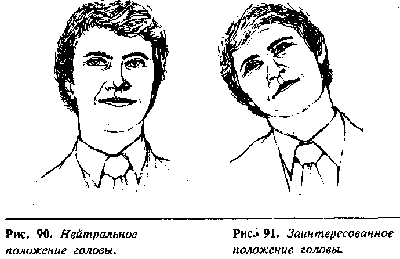
If the head is tilted down, this indicates that the person’s attitude is negative, and even condemning (Fig. 92). A low tilt of the head is usually accompanied by a series of gestures of critical evaluation until you make a person raise his head or tilt it to one side, you will have problems communicating with this person. If you often have to speak in front of an audience, you can often watch how all the people in the room can sit with their heads down and their arms folded over their chests. Professional lecturers and teachers usually do something to increase the interest of the audience before starting their presentation. This requires that the heads of the audience rise, and people become more attentive. If the trick failed, the position of the goals of the audience will change to an inclined side.

Laying Hands for the Head
This gesture is typical for people in such specialties as accountants, lawyers, trade managers, bank managers, or for confident people with a sense of superiority over others: If you could read his mind, you would read: "I know everything" or " Maybe someday you will be as prosperous as I "or even" I control the situation. " This gesture is also characteristic of know-it-alls, and many people get annoyed when someone shows this gesture in front of them. Lawyers often in their midst can demonstrate this gesture to show how knowledgeable they are. It can also be used as a territorial sign by which a person emphasizes that he "staked out" this territory. The man in fig. 93 in addition to this gesture, he crossed his legs in the form of the number "4", which indicates that he not only feels his superiority over others, but also tends to debate and argue.

There are several ways to interact with people who demonstrate this gesture, it depends on the specific circumstances. If you want to find out the reason why a person behaves with a sense of superiority, lean forward with outstretched palms and say: "I see that you know this. Could you comment on this problem?" Then sit back, leave your palms in the field of view and wait for an answer.
Another way is to force a person to change his posture, which in turn will cause a change in his attitude. To do this, you can take an object and, setting aside “a large distance from it, ask:“ Did you not see this? ”, Forcing it to lean forward. A good way to interact is to copy its gesture. If you want to show that you agree with the interlocutor all you have to do is repeat his pose.
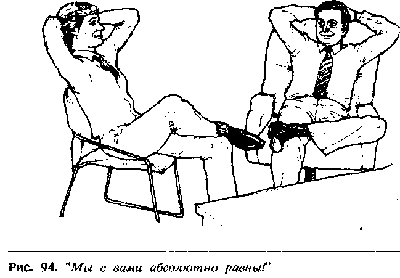
On the other hand, if a person in the "hands behind the head" position makes a remark or imposes a penalty, you should not copy his gesture so as not to piss him off. For example, two lawyers use this gesture in front of each other to emphasize their equality and coordination of actions, but the bully boy will infuriate the school principal if he puts his hands behind his head in his office. The nature of this gesture is unknown, but probably the hands are used to form an imaginary chair in which a person plunges and relaxes.
In the process of examining this gesture, we found that in one insurance company twenty-seven out of thirty managers regularly showed this gesture in the presence of their subordinates - insurance agents, but rarely put their hands behind their heads in the presence of superior persons. In their presence, the same managers used a set of submissive and submissive and protective gestures.
Gestures of Aggressiveness and Readiness for Actions
What gestures are used in the following situations: a child arguing with his parents, an athlete awaiting the start of the competition, and a boxer in the locker room waiting for the start of the round?
In each case, a person stands in a "hands on waist" position, since this is one of the most characteristic gestures used by a person to convey an aggressive attitude. Some researchers refer to this gesture as "readiness", which is correct in some respects, but the main meaning of this gesture is aggressiveness. This posture is also called the “piercing” stance, referring to a focused person who takes such a pose when he is ready to achieve his goal. These observations are true, because in both cases the person is ready to act, but this readiness is still aggressive, offensive. Men often use this gesture in the presence of women to demonstrate their sexually challenging intent.
It is interesting to note that birds dry their feathers to become larger, when they fight or care for a female, people use the “hands on waist” gesture for the same purpose, i.e. to become larger. Men use this as a non-verbal challenge to other men who violate their territorial law.
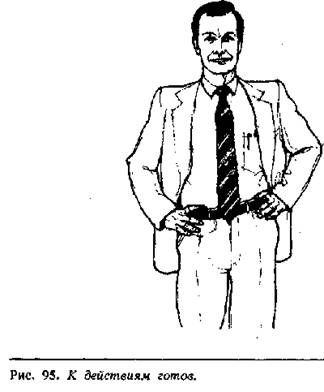
In order to draw the right conclusions regarding the intentions of a person who puts his hands on his belt, it is necessary to consider the circumstances in which this happens and observe the previous gestures. A series of subsequent gestures can strengthen your opinion. For example, is the jacket unfastened and the floor of the jacket folded back, or is it buttoned up when the person puts his hands on his belt? Aggressive pose with a buttoned jacket shows a strong upset, while an unbuttoned jacket and folded tails (Fig. 95) are a purely aggressive pose, because a person opens the area of \u200b\u200bthe heart and throat, showing non-verbal fearlessness. This posture can be more strengthened if the person spreads his legs wide or clenches his fingers into fists.

Gestures of aggressive readiness are used by professional fashion models to convey that their clothes are designed for a modern, aggressive, enterprising woman. Sometimes this gesture is done only with one hand on the hip, the other hand takes a different position (Fig. 96). With this gesture, gestures of critical evaluation are often observed.
Expression of Preparedness by a Seated Man
One of the most valuable gestures that you can learn to recognize is an expression of willingness from a standing person. When presenting a product, for example, if a potential buyer makes such a gesture at the end of the presentation, and the negotiations have successfully reached this point, the sales agent can request an order and can expect to receive it. The video recording of insurance agents negotiating with their clients showed that every time the gesture of “stroking the chin” (making a decision) was replaced by a pose of readiness, the client bought an insurance policy. And vice versa, if at the closing of the presentation the client, after stroking the chin, adopted the pose of arms crossed on his chest, the deal did not end in success. Unfortunately, most training centers teach agents only to request an order, but they do not teach them to observe the client’s posture and gestures. The ability to recognize gestures such as readiness not only helps the business, but also helps to attract as many people as possible to this business. A sitting posture of readiness is also characteristic of an angry person who is ready for anything, even to throw you out of here. A set of previous gestures will allow you to correctly assess the intentions of a person.
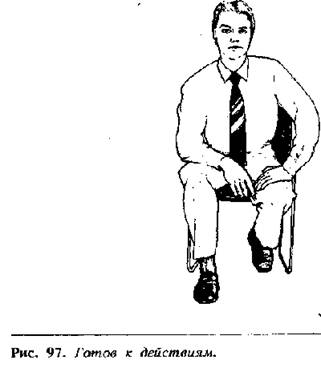
Starting pose
Gestures of readiness, signaling a desire to end a conversation or meeting, are expressed by feeding the body forward, with both hands lying on their knees (Fig. 98), or both hands holding the side edges of the chair (Fig. 99). If any of these gestures appears during a conversation, it would be wise for you to take the initiative in your own hands and be the first to offer to end the conversation. This will allow you to maintain a psychological advantage and control the situation.
![]()
Sexy Defiant Pose
Sexual aggressive posture is expressed by the following gesture - the thumbs are shut by the belt or through the slots in the pockets. This is one of the most popular gestures used by television westerns to show the masculinity of their favorite gangster heroes (Fig. 100). The hands are in a ready position and serve as a center of attraction for attention, emphasizing the genital area. Men use this gesture to mark their territory or show other men that they are not afraid of them. When a gesture is used in the presence of women, it can be interpreted as follows: "I am a man. I rule over you."
This gesture, combined with dilated pupils and, if at the same time, the toe of one leg is directed toward the woman, is well understood by many women. It is thanks to this gesture that all the intentions of the man become apparent, because in such a non-verbal way they explicitly tell the woman what is on their mind. These gestures were always considered purely masculine, but when women began to wear jeans and trousers, they also began to use this gesture (Fig. 101), although they only do this when they are wearing trousers or jeans. When a woman is wearing a dress or something else, a sexually-minded woman puts her thumb on the strap or pocket slot (Fig. 101).

Figure 102 shows two men evaluating each other using characteristic gestures - hands on their hips and fingers on their belts. Given that they both turned away from each other and that the lower halves of their bodies are not strained, it can be assumed that men subconsciously evaluate each other and that an attack is unlikely. Their conversation may be neutral or friendly, but it will not become completely confidential until the gestures “hands on hips” disappear and gestures of open palms appear.

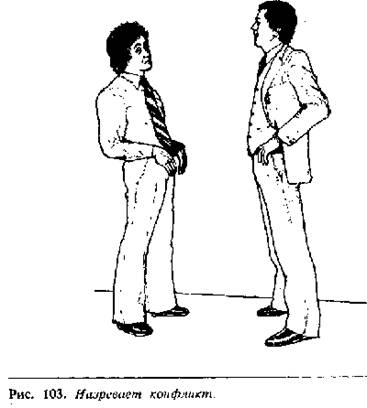
If these men were standing directly opposite each other, and with their feet they would rest firmly on the ground, a fight would be more likely (Fig. 103).
Chapter IX Eye Signals
For many centuries, mankind has been reflecting on the meaning of the view and its effect on human behavior. We all use phrases such as “She has big children's eyes,” “She has an enticing look,” “She cast an angry look at him,” “She has rolling eyes,” “He has such a sparkle in his eyes,” or “He me jinxed it. "
When we say this, we mean the size of the pupils of a person and the behavior of his eyes. In his book, Expressive Eyes, Hess says that the most accurate and open signals of all human communication signals are transmitted through the eyes, because they occupy a central position in the human body, and the pupils behave completely independently.
In daylight, the pupils can expand and contract depending on how the person’s attitude and mood changes from positive to negative, and vice versa. When a person is aroused, his pupils dilate four times against the normal state. On the contrary, an angry, gloomy mood causes the pupils to contract, and so-called "bead eyes" or "snake" eyes are obtained. Eyes play a big role in courtship, women let their eyes down for their expressiveness. If a woman loves a man, then when he sees her, the pupils dilate, and he correctly decrypts this sign, not knowing how he does it. Therefore, romantic dates are often arranged in darkened, poorly lit places, which allows the pupils to expand.

Young lovers look intently into each other's eyes, subconsciously waiting for the expansion of the pupils, each becomes excited by the expanding pupils of the other. Studies have shown that if men show pornographic films depicting men and women in a sexual position, their pupils dilate almost 3 times against the normal state. When the same films are shown to women, their pupils dilate even more than for men, which refutes the theory that women are less excited by pornography than men.
Pupils have more pupils than young adults, and their pupils are constantly expanding in the presence of adults, because children tend to gain their constant attention, and for this you need to look more attractive.
Experiments with qualified card players showed that few of the players won if their opponents wore dark glasses. For example, if an opponent had four aces when playing poker, his pupils would quickly expand, which would be subconsciously noticed by another player, and he would understand that he would better not raise the bet on the next move. The opponent’s dark glasses hid the signals given by the pupils, and as a result the players lost more often than usual.
In ancient times, Chinese pearl merchants also watched their pupils dilate when negotiating prices. Several centuries ago, prostitutes buried belladonna in their eyes to make the pupils expand and look more desirable and attractive. It was noticed that Aristotle Onassis wore dark glasses when negotiating business deals so that his eyes did not betray his thoughts.
An old saying goes, "Look into the eyes of a person when you talk to him." When you are talking with people or negotiating, learn to look into the pupil, and the pupil will tell you the truth about the thoughts of the person.
Eye Behavior
The basis for real communication can be established only when you communicate face-to-face with a person. If while communicating with some people you feel comfortable, then with others you feel uncomfortable and incredulous. This is mainly due to the way they look at you, the length of their gaze, and how long they can hold your gaze.
If a person is dishonest or hides something, his eyes meet yours in less than 1/3 of the total time of communication. If a person’s gaze meets your eyes for more than 2/3 of the time, this can mean one of two things: first, he or she considers you very interesting or attractive, in which case the pupils of the eyes will be dilated; secondly, he or she is hostile to you and non-verbally sends a call; in this case, the pupils will be narrowed. Argyle found that if person A likes person B, then he will often look at him. This prompts B to think that he likes A, so in turn he will fall in love with A. In other words, in order to build good relations with another person, your gaze should meet with his gaze about 60-70% of the total communication time. This will make him love you too. It is not surprising, therefore, that a shackled, modest person who meets your eyes for less than 1/3 of the time is rarely trusted. In negotiations, you should never wear dark glasses, because others will have the feeling that they are "being examined point-blank.
As the language of body movements differs among different peoples, the longitude of a person’s gaze depends on which nation he belongs to. Residents of southern Europe have a high frequency of gaze, which may seem offensive to others, and the Japanese look in the neck rather than the face when talking. Always make a discount on nationality before drawing any conclusions.
But not only the longitude and frequency of the gaze are important, but also the geographical area of \u200b\u200bthe face and body that the gaze is directed to, as this also affects the outcome of the negotiations. These signals are transmitted and absorbed with the help of non-verbalics, and are usually quite accurately interpreted by interlocutors.
It takes about 30 days of constant, intensive practice to learn the next “gaze technology” and apply it effectively to improve the way you communicate with other people.
Business Look
When conducting business negotiations, imagine that there is a triangle on the forehead of your interlocutor. By directing your gaze to this triangle, you create a serious atmosphere, and the other person feels that you are in a businesslike mood. Provided that your view does not fall below the eyes of another person, you will be able to control the progress of negotiations with the help of a look.
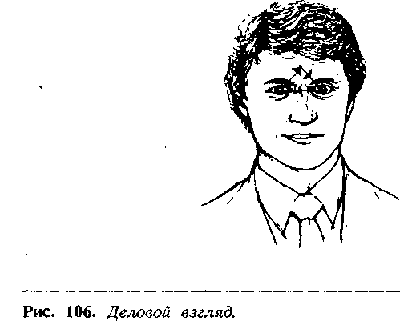
Social Look
If your gaze falls below the level of the eyes of another person, an atmosphere of social communication is created. Experiments on the study of gaze features have shown that during social communication, the eyes also look at the symbolic triangle on the person’s face, in this case located on the line of the eyes and mouth.
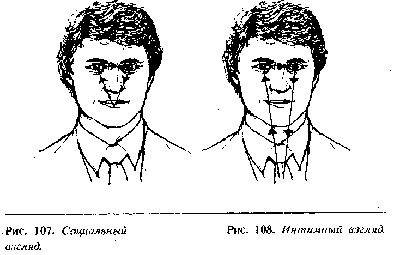
Intimate Look
This look passes through the line of the eyes and descends below the chin to other parts of the interlocutor's body. With close communication, this triangle descends from the eyes to the chest, and with distant communication, from the eyes to the perineum. Men and women with this look show their interest in a person, and if he is also interested, he will respond with the same look.
Sight of Iskos
A squint is used to convey interest or hostility. If accompanied by slightly raised eyebrows or a smile, it means interest and is often used to lure. If it is accompanied by a downcast eyebrow, a frowning forehead or a lowered corner of the mouth, it means a suspicious, hostile or critical attitude.
conclusions
Of great importance for the outcome of a face-to-face meeting is the part of the human body that you are directing your gaze to. If you were the manager, reporting your lazy subordinate, what kind of look would you choose? If you choose a social look, it will not pay any attention to your words, no matter how loud and menacing you are.
A social look will deprive your words of any support, and an intimate look will either perplex or embarrass your employee. The most appropriate look would be a business look, since it can have a strong influence on your addressee and will tell him that you are very serious.
When men say that women look at them "invitingly," they mean squinting or an intimate look. If a man or woman wants to say that they are inaccessible, the only thing they need to do is to avoid an intimate look, and instead use only a social look. If you take a business look during your courtship, you run the risk of being considered cold and unfriendly. The fact is that when you look at a potential sex partner with an intimate look, you immediately give out your intentions. Women know very well how to send and understand this kind of views, but men, unfortunately, do not know how to do this. In men, an intimate look is usually too noticeable, but they themselves do not notice when they look at them with an intimate look, much to the chagrin of women who sent this look.
Covered eyelids
Most of all we are annoyed by people who lower their eyelids during a conversation. This gesture is subconscious and is an attempt by a person to remove you from his field of vision, because you are tired of him or become uninteresting, or he feels his superiority over you. At a normal blink rate of 6-8 times per minute, this person’s eyelids close for a second or more, as if the person instantly erases you from his memory. The maximum degree of disconnection can occur if a person closes his eyes and falls asleep, but this rarely happens when meeting face to face.
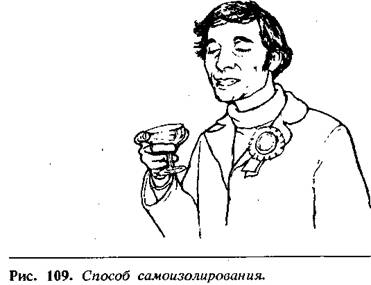
If a person emphasizes his superiority over you, his covered eyelids are combined with his head thrown back and a long look, known as a downward glance. If you noticed this look from your interlocutor, keep in mind that your behavior causes a negative reaction and you need to change something if you are interested in successfully ending the conversation (Fig. 109).
How to control the look of the interlocutor
It makes sense to talk now about how to control a person’s gaze during the visual presentation of books, tables, graphs, etc. Studies show that 87% of the information goes into the human brain through the visual receptors, 9% through the auditory and 4% through the other senses. If, for example, you show a person your visual aid and at the same time talk about him, he will understand only 9% of your message, unless it is directly related to what he sees. If your message is connected with a visual aid, then when you look at it, he will learn only 25-30% of your message. To establish maximum control over his attention, use a pen or pointer to show on a visual aid and describe what is depicted (Fig. 110). Then, take the pen away from the visual aid and keep it in the line of yours and his eyes (Fig. 111). Like a magnet, his head will rise and he will look into your eyes, as a result of which he will see and hear everything that you tell him, and, therefore, absorb information as much as possible. Try to make the palm of the other hand in sight.
A simple crossing of hands is a universal gesture indicating the defensive state of the interlocutor. Such a gesture should always be expected from a person who is among strangers, for example, in a queue, elevator, cafe or at a public meeting. The gesture gives out a feeling of uncertainty and danger.
As long as a person keeps his arms crossed on his chest, he will maintain a poor disposition towards his interlocutor. The inner tension leads to this gesture. However, keeping the arms crossed only maintains this tension, preventing him from leaving.
Very often, the gesture “arms crossed on the chest” expresses a person’s disagreement with what he hears. Many politicians cannot make a good, fiery speech because they do not pay attention to the appearance of this gesture in the audience. Meanwhile, experienced speakers, noticing this gesture, immediately try to take measures to help change the categorical mood of the audience, forcing people to take a more receptive posture. Thus, the talking person can change his attitude from negative to more friendly.
If a person crosses his arms during a face-to-face conversation, this means that something was said in his interlocutor’s words with which he does not agree. At the same time, he can express his consent in words, but the gesture of “crossed arms” indicates another. In this situation, one should trust more non-verbal signs than words, and try to find out the reason for such a reaction of the interlocutor. After this, you should correct the situation and encourage a person to take a more comfortable posture.
Making a person open the lock is very easy. To do this, you just need to give him something, such as a pen, notebook, book, any object, for which he will have to lend a hand. Thanks to this technique, a person will take a pose more disposed towards the interlocutor, and his attitude towards him will immediately change.
Another simple trick that forces a person to open their hands is to lean forward to consider something better. You can also lean forward yourself, with your palms open, and ask: "You probably have questions? What would you like to know?" or "What is your opinion on this?" After this question, you should lean back, making it clear that it was the turn of the interlocutor to speak. When asking a question with open hands, a person nonverbally says that he would like to hear an open and honest answer from his interlocutor.
In a further conversation, you should change your words and actions that encourage the interlocutor to evade the discussion, closing himself with a barrier from bound hands.
It should also be borne in mind that the gesture “arms crossed on the chest” can affect the behavior of other people. If in a group of four or more people cross their arms in a protective pose, then soon you can expect that other members of the group will follow his example. It is very rare that this gesture simply means calm and confidence, but this can only be said when the atmosphere of the conversation is not conflict-like.
Sometimes, in addition to arms crossed on the chest, the interlocutor begins to compress his fingers into a fist. Such a gesture signals his hostility and readiness for an attack. At the same time, a person often clenches his teeth, and his face turns red from exertion. In this case, one should expect a verbal, and sometimes a physical attack from a person.
In such a situation, you should slow down your speech and movements, as if inviting the person you are talking to to follow this example. If this does not help, try to change the subject of the conversation. You can also try to calm the interlocutor with a gesture using open palms.
Psychologists have noticed that such a gesture is rarely characteristic of people who, by the nature of their activity, wear bulletproof vests. They rarely use gestures with arms crossed, because they do not need such self-defense, having weapons and a vest. However, militiamen, bodyguards, or simply security guards sometimes cross their arms and clench their fingers into fists when they are on duty. With this gesture, they seem to make it clear to everyone around that no one will pass by them into the protected area.
Arms crossed shoulders
In this position, the hands are as if pressed into the shoulder of the opposite hand. They can be squeezed to such an extent that the phalanges of the fingers turn white, since blood does not come to them. This gesture subconsciously protects the chest from shock. It expresses containment of negative feelings.
Such a gesture can often be seen in a person who is in the reception room of the director or in the office of the dentist, as well as in the cabin before taking off for passengers who are flying for the first time.
In the courtroom, one can observe how the prosecutor and lawyer have their hands folded on their chest, but the prosecutor’s fingers are clenched into fists, while the lawyer’s arms are wrapped around the shoulder of the arm.
Crossed arms with thumbs raised.
This gesture is also defensive or defensive. It developed from a gesture with two horizontally extended arms and vertically extended thumbs. Such a gesture speaks of a person’s confidence and self-control. Adding crossed arms to the gesture gives a feeling of security to a person who is self-confident, but who has felt a threat from his position. In fact, a person subconsciously demonstrates to his opponent a sense of superiority over him.
Partial hand protection
The full gesture of "arms crossed on the chest" too clearly tells others about the fear experienced. Therefore, often a person uses partial, incomplete crossbreeding. With this gesture, one arm is placed across the body and secured to the other arm, which hangs freely along the body. It turns out "partial protection by hands."
As a rule, a person uses such a gesture when he is in the company of strangers.
Sometimes a person uses another gesture of partial protection. At the same time, arms are lowered, only palms are crossed. Such a gesture is typical for people who are on stage or facing a large audience, for example, when receiving an award or making a speech.
Disguised Crossing Activities
The unwillingness to clearly show people your fear and anxiety has led to the fact that many gestures have become more disguised, refined. This is especially true for people who are constantly in the spotlight, for example, politicians, salespeople or TV presenters who do not want viewers to notice their nervousness or self-doubt.
A disguised gesture is the movement of a hand across the body toward the other hand. However, at the same time, people do not touch their hands, but watch, cufflinks, bracelets, handbags and other objects that are on the other hand or next to it. Previously, passing through a crowded room, men began to correct cufflinks, which testified to their excitement. Currently, men are adjusting the watch strap, checking the contents of their purses, pulling a button - doing everything that allows them to hold their hands across the body.
All of these gestures are made in order to hide their own nervousness and excitement.
Especially often these gestures appear in places where a person has to pass by people watching him. For example, when a person goes through a dance hall to invite a girl to dance, or when a person leaves the hall on the stage to receive a reward.
Women more subtly mask their protective gestures. Hiding their self-doubt or fear, they hold on to a purse or wallet.
If you carefully observe people, you will find that almost all resort to the use of disguised protective gestures in certain circumstances. People make such gestures in stressful situations, and most often this happens unconsciously.
Crossed legs
Protective barriers are formed not only with the help of hands, but also with legs. However, crossed legs carry a less negative connotation. Crossed arms symbolize the protection of the heart and chest area, and crossing the legs reflects an attempt to protect the genitals.
There are two main gestures using crossed legs in a sitting position:
- classic pose;
- pose when the foot is laid on the foot in the form of the number "4".
The first gesture, when one leg rests neatly on the other (usually the right on the left), is often used by Europeans. However, this gesture can also express an agitated state, a defensive reaction, or restraint.
This gesture may be accompanied by other negative gestures, so it should be interpreted only in conjunction with them. For example, a person sits cross-legged during lectures due to an uncomfortable seat or cold. If the “foot to foot” pose is accompanied by the crossing of arms on the chest, this may mean that the person has withdrawn from the conversation. If the buyer takes this position, one should not rush to ask him about the decision made, it is better to find out his objections. This pose is especially popular among women. They often resort to her when they want to express their dissatisfaction with her husband or friend.
Crossed legs in women do not always mean a defensive position. They can be the result of upbringing, when girls from childhood are taught to sit with their legs crossed.
Cross-legged with the appearance of the number 4 is a gesture, very popular among male Americans. He expresses a fighting spirit. But because of popularity, it’s hard to judge whether this pose has such a meaning or not. When an Englishman takes such a pose, there is no doubt in his decisive mood.


